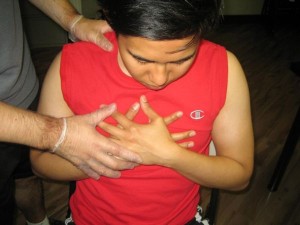A chest injury is any external trauma caused by either an intentional or an accidental penetration of a foreign object into the chest., which can potentially harm the underlying organs. The chest cavity, also called the thoracic cavity, houses some of the body’s most vital organs, the heart and the lungs. With any kind of chest injury, it is necessary to seek medical treatment as soon as possible, despite the lack of any symptom. It may not always be evident directly after the cause of injury but some potential complications of chest injuries include damage to the underlying organs and even spinal injuries.
There are many different types of chest injuries. They are categorized either as a serious chest injury or as minor chest injury. Serious chest injuries can cause damage to the other organs that are not necessarily in the chest cavity, such as the stomach, kidney, liver, and trachea, whilst minor chest injuries can lead to pain upon movement of the shoulder, arm, rib cage or the trunk of the body.
- Fractured ribs – most common chest injury
- Pneumothorax (collapsed lung)
- Flail segment
- Sucking or open chest wound
Causes of Chest Injury
Chest injuries are frequently caused by external trauma to the chest, however, it can also be caused by blunt trauma leading to chest wall injury and therefore causing damage. The following are the most common causes of chest injury to an individual:
- Motor vehicular accidents
- Physical assaults
- Falls from great heights
- Penetrating foreign bodies, such as from gunshot, stab, bite, or blast wounds
Signs and Symptoms of Chest Injury
It is absolutely necessary to recognize any chest injury. Although there may not always be an evident external injury, it does not necessary mean that there is no internal injury. Significant internal injury can occur even without the following signs and symptoms:
- Chest pain that worsens upon movement
- Pain at the site when inhaling, severity depends on the type of injury
- Difficulty breathing, rapid shallow breathing
- Chest cannot expand normally
- Coughing up blood
- Quick pulse
- Bruising
- Crunching sounds in the ribs
- Obvious deformity
- Possible altered conscious state
- Cyanosis of the skin
- One segment of the chest wall may not move with breathing or move opposite to the rest of the chest wall (flail chest)
First Aid Treatment and Management for Chest Injury
For any chest injury, call for emergency medical services immediately. It is necessary to have it checked by a professional to rule out any serious damage.
- Initiate CPR if necessary or whenever essential.
- For any bleeding, apply deep pressure to control bleeding using any clean cloth or dressing.
- If there is an open wound, use a clean piece of cloth, pad, plastic, or whatever is at hand to apply cover two inches beyond all edges of the wound. Ensure that there is no air buildup in the chest. Signs of these include blood bubbling from the wound or hearing air pass through the cavity.
- Do not remove any object that has penetrated the chest.
- Position the person on the injured side or sitting up, if possible.
To learn how to effectively treat and manage chest injury, enroll in First Aid and CPR Courses with workplace approved training.
Online Sources:
http://www.emedicinehealth.com/wilderness_chest_injuries/article_em.htm#chest_injuries_overview
http://www.slideshare.net/nhliza/first-aid-for-chest-injury
http://www.webmd.com/pain-management/tc/types-of-chest-injuries-topic-overview
http://www.webmd.com/first-aid/chest-injury-treatment

